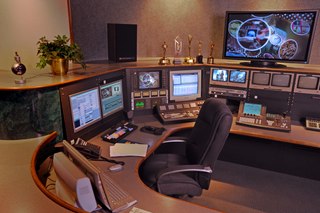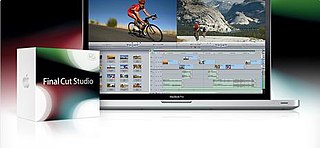Related Research Articles
Adobe Photoshop is a raster graphics editor developed and published by Adobe Inc. for Windows and macOS. It was originally created in 1987 by Thomas and John Knoll. Since then, the software has become the most used tool for professional digital art, especially in raster graphics editing. The software's name is often colloquially used as a verb although Adobe discourages such use.

Video editing software, or a video editor is software used for performing the post-production video editing of digital video sequences on a non-linear editing system (NLE). It has replaced traditional flatbed celluloid film editing tools and analog video tape editing machines.

Non-linear editing is a form of offline editing for audio, video, and image editing. In offline editing, the original content is not modified in the course of editing. In non-linear editing, edits are specified and modified by specialized software. A pointer-based playlist, effectively an edit decision list (EDL), for video and audio, or a directed acyclic graph for still images, is used to keep track of edits. Each time the edited audio, video, or image is rendered, played back, or accessed, it is reconstructed from the original source and the specified editing steps. Although this process is more computationally intensive than directly modifying the original content, changing the edits themselves can be almost instantaneous, and it prevents further generation loss as the audio, video, or image is edited.

Pro Tools is a digital audio workstation (DAW) developed and released by Avid Technology for Microsoft Windows and macOS. It is used for music creation and production, sound for picture and, more generally, sound recording, editing, and mastering processes.
A scorewriter, or music notation program is software for creating, editing and printing sheet music. A scorewriter is to music notation what a word processor is to text, in that they typically provide flexible editing and automatic layout, and produce high-quality printed results.
An edit decision list or EDL is used in the post-production process of film editing and video editing. The list contains an ordered list of reel and timecode data representing where each video clip can be obtained in order to conform the final cut.
Adobe Audition is a digital audio workstation developed by Adobe Inc. featuring both a multitrack, non-destructive mix/edit environment and a destructive-approach waveform editing view.
Soundtrack Pro is a discontinued music composing and audio editing application made by Apple Inc. It included a collection of just over 5,000 royalty free professional instrument loops and sound effects for use. The software was featured in the Logic Studio and Final Cut Studio software bundles; It was discontinued with the release of Final Cut Pro X, Motion 5, and Compressor 4.

Final Cut Pro is a professional non-linear video-editing application initially developed by Macromedia, and, since 1998, by Apple as part of its pro apps collection. Final Cut Pro allows users to import, edit, and process video footage, and output it to a wide variety of formats.
Adobe Premiere Pro is a timeline-based and non-linear video editing software application (NLE) developed by Adobe Inc. and published as part of the Adobe Creative Cloud licensing program. First launched in 2003, Adobe Premiere Pro is a successor of Adobe Premiere. It is geared towards professional video editing, while its sibling, Adobe Premiere Elements, targets the consumer market.

Vegas Pro is a video editing software package for non-linear editing (NLE). The first release of Vegas Beta was on 11 June 1999. The software runs on Windows operating systems.
Final Cut Express was a video editing software suite created by Apple Inc. It was the consumer version of Final Cut Pro and was designed for advanced editing of digital video as well as high-definition video, which was used by many amateur and professional videographers. Final Cut Express was considered a step above iMovie in terms of capabilities, but a step underneath Final Cut Pro and its suite of applications. As of June 21, 2011, Final Cut Express was discontinued in favor of Final Cut Pro X.

Final Cut Studio is a discontinued suite of professional video production and post-production made by Apple for the Mac. The suite competed with Avid Media Composer for the high-end movie production market. It first went on sale in 2005.
Open Media Format (OMF), Open Media Framework, or Open Media Framework Interchange (OMFI), or is a platform-independent file format intended for transfer of digital media between different software applications.
Aperture is a discontinued professional image organizer and editor developed by Apple between 2005 and 2015 for the Mac, as a professional alternative to iPhoto.
This is a comparison of non-linear video editing software applications. See also a more complete list of video editing software.
AVC-Intra is a type of video coding developed by Panasonic, and then supported in products made by other companies. AVC-Intra is available in Panasonic's high definition broadcast products, such as, for example, their P2 card equipped broadcast cameras.
Boris FX is a North American visual effects and video editing software plug-in developer based in Boston, Massachusetts, USA. The developer is best known for its four flagship products, Continuum, Sapphire, Mocha, and Silhouette.
GenArts, Inc. was a Cambridge, Massachusetts-based developer of visual effects software for the film, broadcast, and advertising industries. A majority of traditional video content, such as movies, commercials, television shows, newscasts, and music videos, included at least some special effects created by a GenArts product. GenArts created visual effects software and plugins that integrate visual effects such as glows, lightning, fire, and fluids into post-production video editing software from companies like Apple, Adobe, Autodesk, and The Foundry.
Aurora HDR is photographic software developed by Skylum Software for Mac OS X and Windows. It is designed to be a powerful and simple yet fast HDR photo editing software.
References
- ↑ AE and Avid, Strategic Lessons for Success Archived February 2, 2009, at the Wayback Machine , tutorial that originally appeared on the WWUG website
- ↑ Automatic Composition Import press release, February 26, 2001
- ↑ NAB 2001 -- An Editor's Report
- ↑ Automatic Composition Import FCP announcement press release, December 5, 2001
- ↑ Automatic Sequence Export Pro announcement, July 1, 2002
- ↑ MacWorld magazine review, February 1, 2003
- ↑ Pro Import FCP announcement, December 8, 2003
- ↑ Pro Import C3 announcement, June 28, 2004
- ↑ Interview with Wes Plate, President, Automatic Duck Archived February 25, 2009, at the Wayback Machine
- ↑ Moving Pictures Collective Meeting Report, June 18, 2008